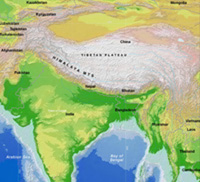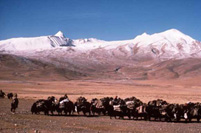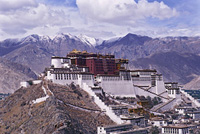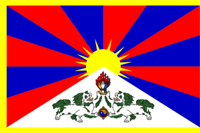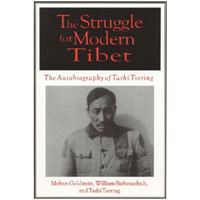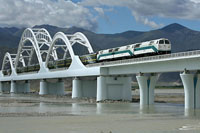
Jochen Welsch
Wachusett Regional High School
Tibet in the AP World History Framework
One way of teaching the period 600 - 1400 is to explain how the religious, political and economic created during the classical period expanded into what had previously been peripheral or frontier regions during the axial age. Kingdoms emerged in the Tibetan plateau and were unified into a larger empire. Buddhist ideology diffused into the region through missionaries, merchants and political sponsorship integrating the Tibetan plateau into the larger Indic and Sinic worlds. Eventually religious strife fragmented the empire and a feudal system dominated by monasteries defined the region. Throughout the period Tibetan created a distinct culture by adopting foreign ideas and incorporating them into local traditions. As such Tibet serves as an excellent tool for examining change over time.
Other themes necessary to understand this period include the rise of nomadic peoples (Mongols, Turks, Vikings & Polynesians) as well as the relationship between these new powers and the people they conquered. Here again the history of Tibet is instructive as it became linked to the Mongol ecumene. Click on my powerpoint Cross-Cultural Interactions to further explore the history of Tibet during this dynamic period.
The emergence of Islam is undoubtedly one of the biggest themes for this period. While Islam had little direct effect on Tibet during this period, students could compare the spread of Islam into West Africa with Buddhism into Tibet to look for patterns as well as differences between the two. (see my activity below)
Resources for further research and classroom extension activities:
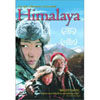 An excellent ethnographic film about a salt caravan in a Tibetan community in Nepal. Although not technically about this period, this excellent ethnographic film is useful for teaching the concept of syncretic religion. A useful activity would be to have students choose three scenes where religious practices are shown and the research how this practice relates to Buddhist ideology and if it had earlier indigenous roots. They might also research if these practices are common in other Buddhist cultures. A discussion of their work will help the class improve their understanding of Buddhist practices
An excellent ethnographic film about a salt caravan in a Tibetan community in Nepal. Although not technically about this period, this excellent ethnographic film is useful for teaching the concept of syncretic religion. A useful activity would be to have students choose three scenes where religious practices are shown and the research how this practice relates to Buddhist ideology and if it had earlier indigenous roots. They might also research if these practices are common in other Buddhist cultures. A discussion of their work will help the class improve their understanding of Buddhist practices
 A good read about the role the Mongols played in diffusing ideas across Eurasia thereby setting the stage the seminal events of later periods.
A good read about the role the Mongols played in diffusing ideas across Eurasia thereby setting the stage the seminal events of later periods.
Writing activity: Compare the spread of Buddhism into Tibet with the spread of Islam into West Africa. How did each region use the contacts generated by the introduction of each religion to create new political, economic and social structures. What other changes accompanied these new religions?
Discussion/ Research project: Examine the use of butter in Tibetan religious rituals. How do these rituals help explain the concept of syncretic religions
 This site was created by Jochen Welsch at the NEH Summer Institute "Literatures, Religions, and Arts of the Himalayan Region," held at the College of the Holy Cross, Summer 2008.
This site was created by Jochen Welsch at the NEH Summer Institute "Literatures, Religions, and Arts of the Himalayan Region," held at the College of the Holy Cross, Summer 2008.